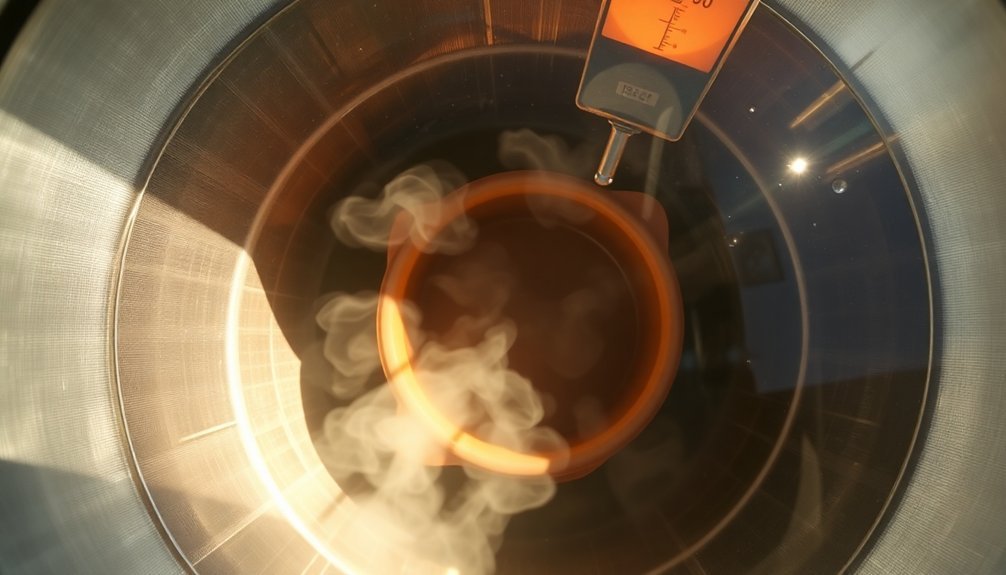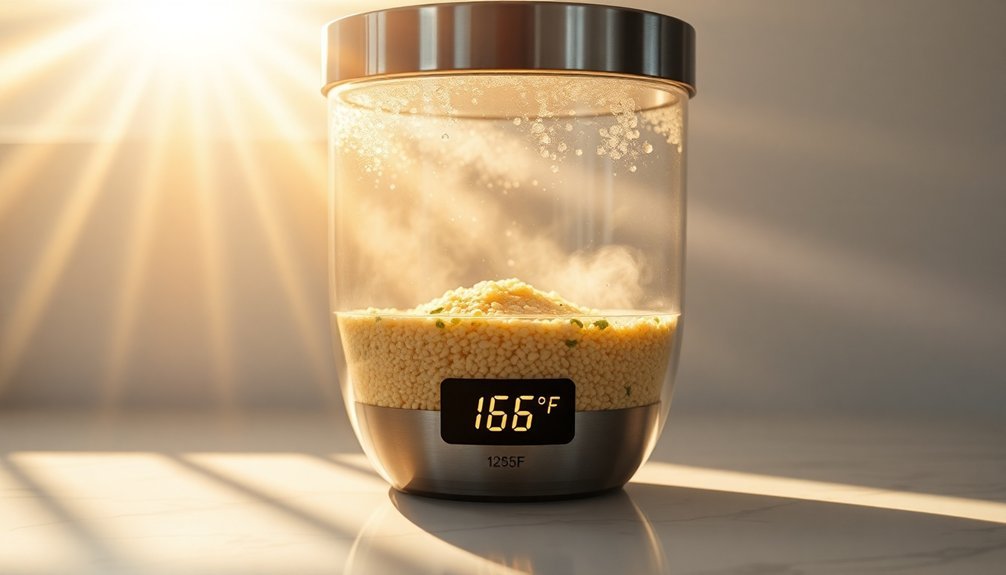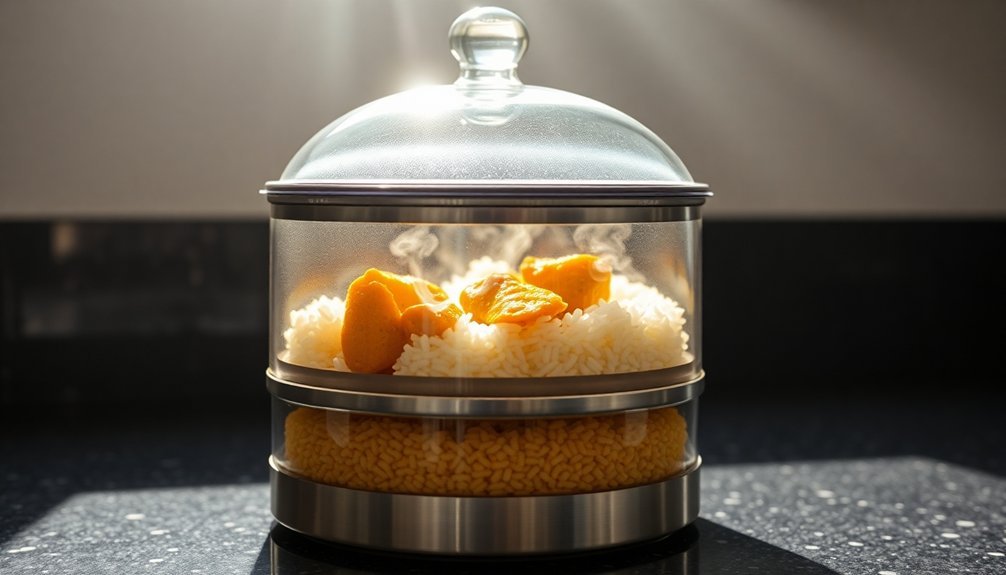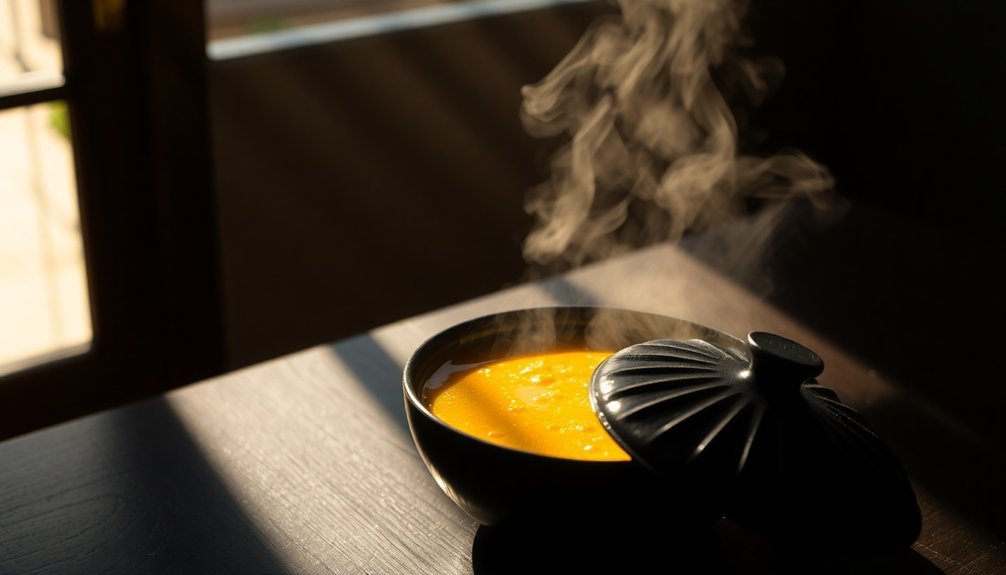Your sunlight meals stay hot and stable thanks to several key factors working together. The glass cover acts like a heat trap, letting sunlight in while preventing warmth from escaping. Dark cooking vessels with tight-fitting lids absorb and retain heat efficiently, while multiple layers of insulation materials like foam and aluminum help maintain steady temperatures between 150-225°F. Proper sun tracking every 30-45 minutes guarantees consistent heat exposure during peak hours (11 am – 3 pm). Advanced thermal storage designs and smart materials further enhance stability. Understanding these elements can transform your solar cooking experience into a reliable, energy-efficient method.
The Science Behind Solar Heat

While many people think of solar energy primarily for electricity, understanding how sunlight converts to usable heat is key to solar cooking. When sunlight hits your solar cooker's glass cover, it passes through and excites the molecules in the dark, absorbing surfaces beneath. The glass then acts like a heat trap, preventing the warmth from escaping – similar to how a greenhouse works.
Modern solar cookers often incorporate evacuated tube collectors for enhanced efficiency and heat retention. You'll find this heat transfer happening through three main mechanisms. The sun's radiation first travels through space to reach your cooker.
Then, conduction moves heat through the cooking vessel's material, while convection currents in the air help distribute the warmth evenly. The temperature difference between the hot absorbing surface and your food drives this heat transfer, ensuring your meal cooks thoroughly.
Heat Trapping Materials That Work
Building on the principles of solar heat transfer, selecting the right materials for trapping and maintaining temperature makes all the difference in solar cooking success.
You'll find that insulated packaging with multiple layers works best, combining HDPE or PP outer layers with EPS or polyurethane foam middle layers and food-grade inner linings. Similar to how traffic monitoring helps optimize server performance, carefully tracking cooking temperatures ensures optimal heat distribution.
For best heat retention in your solar meals, consider these key container options:
- Aluminum containers reflect heat waves and withstand temperatures up to 400°F, perfect for intense solar cooking.
- Polypropylene vessels handle up to 230°F and provide excellent heat conduction with minimal burn risk.
- Paper containers, while limited to 180°F, offer comfort and functionality for soups and lighter fare.
Each material serves specific purposes in solar cooking, helping you maintain ideal food temperatures while ensuring safety and convenience.
Smart Temperature Control Techniques

Successful solar cooking hinges on mastering precise temperature control through strategic positioning and monitoring. You'll need to face your solar oven directly toward the sun and adjust it every 30-45 minutes to maintain ideal exposure. Using a sun angle finder helps you achieve the perfect alignment.
To regulate temperature effectively, you'll want to monitor your cooker with a reliable thermometer, aiming for 150-225°F. You can control heat levels by opening or closing pot lids and adjusting reflective panels. For enhanced precision, Type-K thermocouples provide exact readings. Box-within-box designs can significantly improve heat retention and temperature stability.
If you're tech-savvy, consider implementing automated tracking with servo motors that make real-time adjustments. Remember to preheat your cooker and choose dark, lidded cookware to maintain stable temperatures.
Protect your setup from wind interference by selecting a sheltered cooking spot.
Mastering Solar Cooking Time
You'll get the best results from your solar cooker by tracking the sun's position throughout the day and adjusting your cooker's angle every 30 minutes for ideal exposure.
The prime cooking window falls between 11:00 am and 3:00 pm when sunlight is most intense, so plan your meals around these peak hours.
To maintain steady cooking temperatures, use dark cookware with tight-fitting lids and consider adding thermal mass like bricks to help retain heat longer. In regions with snow cover, positioning your solar cooker to capture reflected sunlight can enhance cooking performance even during winter months.
Tracking Sun Angle Changes
To master solar cooking, understanding how to track and adjust for changing sun angles is essential. You'll need to take into account your location, as areas closer to the equator receive more direct sunlight than northern regions. The sun's position changes throughout the day and seasons, affecting your cooking efficiency.
For ideal results, follow these key steps:
- Position your cooker during peak hours (11 AM to 3 PM) when the sun's directly overhead.
- Adjust reflective surfaces regularly, using tools like rulers to maximize sunlight concentration.
- Monitor seasonal changes, as winter requires more frequent adjustments than summer.
You'll find box and parabolic cookers work best in winter since they're better at compensating for sun angle variations.
Heat Retention Techniques
Maintaining consistent cooking temperatures in solar cookers requires mastering multiple heat retention techniques. You'll achieve peak performance by using double-glazed panels with precise air spacing, sealed with high-temperature silicone caulk to prevent moisture infiltration.
Dark surfaces, like black paint or cast iron pots, will absorb up to 95% of available solar radiation. You can maximize heat retention by surrounding your cooking cavity with insulating materials like rockwool or polystyrene sheets.
Adding aluminum foil as a radiant reflector and maintaining a vapor barrier will protect against heat loss and moisture damage. When the sun's intensity diminishes, shift to heat-retention cooking by placing your heated food in an insulated box.
Keep the lid closed until serving time, and use insulating pads to maintain close contact between pots and heated surfaces.
Ideal Cooking Time Windows
Successful solar cooking depends heavily on choosing the right time window for meal preparation.
You'll get the best results between 11:00 am and 3:00 pm when the sun's overhead position delivers maximum UV radiation. While you can start preheating as early as 10:00 am, it's essential to track the sun's movement and adjust your cooker accordingly.
For ideal cooking efficiency, you'll want to:
- Rotate your solar oven every 30 minutes to follow the sun's path
- Place the cooker in direct sunlight with properly angled reflectors
- Allow for longer cooking times compared to conventional ovens
Thermal Storage Design Innovations

While thermal energy storage has existed for decades, recent innovations in design and materials have revolutionized its potential for solar cooking applications.
You'll find advanced phase change materials that store and release large amounts of energy during melting and solidifying, keeping your meals at consistent temperatures. The latest systems incorporate smart layered designs that reduce heat loss by over 70%, ensuring your food stays hot longer.
Modern thermal storage units in solar cookers now feature modular components that you can customize based on your cooking needs.
They're equipped with real-time monitoring capabilities that adjust to changing conditions, maintaining ideal temperatures throughout your cooking process.
When combined with high-heat capacity materials and natural salts, these innovations create a stable, efficient cooking environment that rivals traditional stovetops.
Heat Retention Through Insulation
You'll find that layering multiple types of insulation creates a more effective thermal barrier than using a single material, as each layer targets different forms of heat loss.
Smart insulating materials with phase-change properties can trap and release heat based on temperature fluctuations, maximizing your system's efficiency.
Preventing thermal bridges through strategic placement of insulation at joints and connections guarantees there aren't any weak points where heat can escape your solar cooking setup.
Multiple Insulation Layer Benefits
Because heat retention is essential for effective solar cooking, multiple layers of insulation provide significant advantages in maintaining stable temperatures.
When you use multiple insulation layers in your solar cooker, you'll create a more effective barrier against heat loss through joints and thermal bridging. The staggered arrangement of layers works better than simple joint taping, helping you maintain consistent cooking temperatures.
Your multi-layered setup offers these key benefits:
- Enhanced energy efficiency by slowing down heat transfer and reducing the rate of heat loss
- Better protection against temperature fluctuations through staggered joints that prevent direct heat paths
- Reduced moisture buildup, which helps protect your cooker's components and maintains ideal cooking conditions
This advanced insulation approach guarantees your meals stay at the right temperature longer, making your solar cooking more reliable and effective.
Smart Material Heat Trapping
As solar cooking technology advances, smart materials have revolutionized heat retention through innovative insulation methods. Your solar cooker now benefits from adaptive insulation that switches between conducting and insulating states based on temperature changes, much like a semiconductor responds to electrical signals.
You'll find that these smart materials work in three ways to keep your meals hot: they block heat radiation, prevent convection losses, and control conduction.
When you're cooking, phase-change materials absorb and store excess heat, releasing it gradually to maintain stable temperatures.
If you're using newer models, they might include aerogel or vacuum insulation panels that trap heat more effectively in a thinner layer. This technology helps you save energy while ensuring your food stays at the perfect temperature throughout the cooking process.
Thermal Bridge Prevention Methods
While maximizing energy efficiency in solar cooking, preventing thermal bridges plays an essential role in maintaining consistent temperatures.
You'll want to focus on creating continuous insulation layers that prevent heat from escaping through gaps or weak points in your cooking setup.
To effectively prevent thermal bridges in your solar cooking system:
- Apply continuous rigid insulation around your cooking chamber, ensuring there are no gaps where heat can escape.
- Use specialized materials like aerogel blankets or vacuum insulation panels under and around your cooking surface for superior heat retention.
- Install proper sealing around any openings or access points where thermal bridging commonly occurs.
When retrofitting existing solar cookers, you can inject foam insulation into cavities or add external insulation layers to improve overall thermal performance.
Remember to carefully detail around windows and vents to maintain ideal efficiency.
Frequently Asked Questions
Can Solar-Cooked Food Spoil if Left in the Cooker Overnight?
Yes, you'll risk food poisoning if you leave solar-cooked food in the cooker overnight. If it stays in the danger zone (50-125°F) for 3-4 hours, bacteria will grow and you should discard it.
How Do Different Weather Conditions Affect the Taste of Solar-Cooked Meals?
You'll notice your food tastes best on clear days with consistent sunlight, while partly cloudy conditions can make flavors less intense. Overcast weather greatly affects taste quality since food doesn't cook properly.
Is It Safe to Cook Raw Meat in a Solar Cooker?
Yes, you can safely cook raw meat in a solar cooker if you maintain temperatures between 200-300°F, use a digital thermometer to check internal temperatures, and guarantee it doesn't stay in the danger zone.
What Happens if Birds or Insects Land on the Reflective Surfaces?
If birds or insects land on your solar cooker's reflective surfaces, they'll block sunlight and reduce cooking efficiency. They can also damage the surfaces through scratching or pecking, requiring repairs to maintain peak performance.
Can Solar Cookers Be Used Effectively in High-Altitude Mountain Regions?
Yes, you can use solar cookers effectively at high altitudes. You'll actually benefit from increased solar radiation, but you'll need to adjust cooking times and guarantee proper insulation to compensate for cooler temperatures.
In Summary
You'll find that successful solar cooking combines careful material selection with smart heat management. By using proper insulation, thermal storage, and timing techniques, you're able to keep your meals at stable temperatures throughout the cooking process. Whether you're using a basic solar box or an advanced parabolic cooker, these principles guarantee your sun-cooked food stays hot and ready when you need it.





Leave a Reply